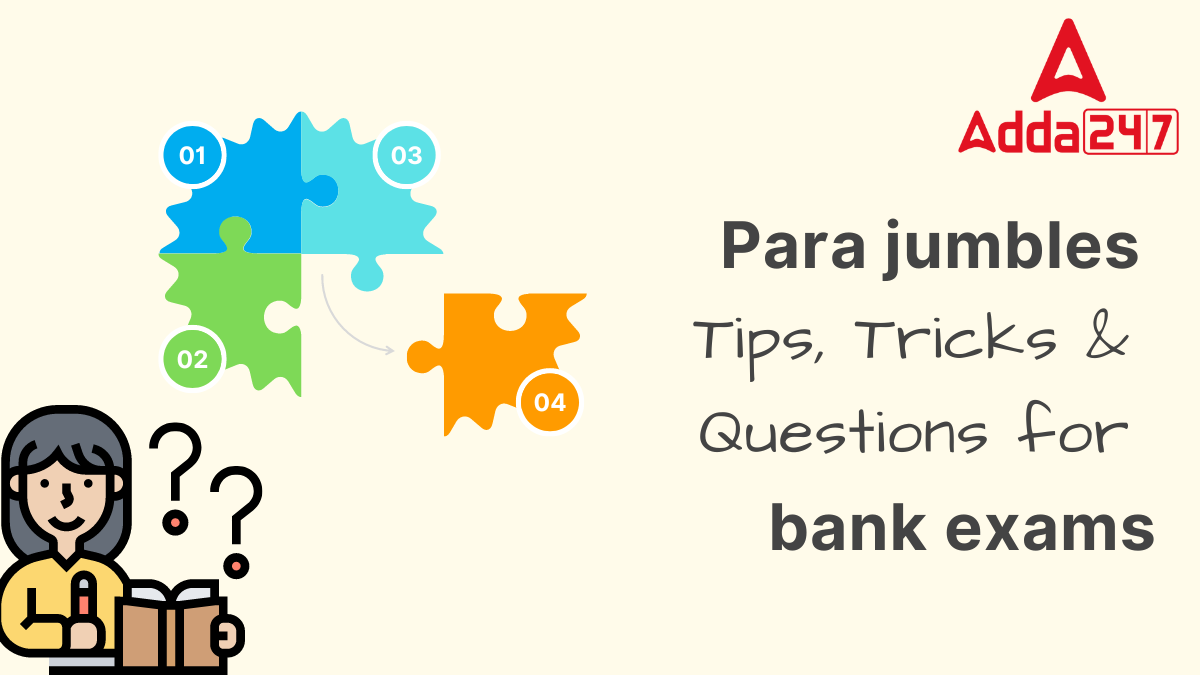Table of Contents
Para Jumbles, also known as Sentence Rearrangements, are a common part of the English Section in various competitive examinations, including bank exams. This type of question tests the candidate’s ability to understand the sequence idea within a paragraph. In this column, candidates can examine the tips, tricks and practice questions of para jumbles.
Para Jumbles: Meaning
Para jumbles involve a set of sentences in a jumbled order. The task is to rearrange these sentences into a logical and meaningful paragraph. The sentences, when correctly ordered, should flow smoothly from one idea to another, maintaining logical consistency and its theme.
Tips & Tricks to Solve Para Jumbles
- Identify the Theme: Read all the sentences to get a general idea of the topic or theme. This will help identify the introductory sentence and the concluding sentence.
- Look for the Opening Sentence: The first sentence usually introduces the topic and does not start with a conjunction or a pronoun that refers to something mentioned earlier.
- Find Logical Connections: Look for sentences that logically follow one another. This can be done by identifying connectors like ‘and’, ‘but’, ‘however’, or sequence indicators like ‘firstly’, ‘secondly’, etc.
- Identify Pronoun References: Sentences with pronouns (he, she, it, they, etc.) often follow the sentences where the nouns they refer to are mentioned.
- Connect Similar Ideas: Group Sentences that discuss similar ideas or aspects of the same topic. This helps in forming coherent sub-groups which can then be arranged.
- Sequencing of Events: In narratives or processes, sequence words (first, then, after, finally) can guide you in arranging the sentences.
- Practice Regularly: The more practice, the better at identifying patterns and logical sequences in jumbled sentences.
Mistakes to Avoid
- Skipping the Reading: Not reading all sentences before attempting to arrange them can lead to misunderstandings of the theme.
- Ignoring Connectors: Overlooking connectors that indicate relationships between sentences can disrupt the logical flow.
- Forgetting Theme: Focusing too much on individual sentences without considering the overall context can lead to incorrect sequencing.
Practice Questions
Directions (01-05): Rearrange the following sentences in the proper sequence to form a meaningful paragraph. Then answer the questions given below them.
(A) With renewed confidence, she took a deep breath and continued.
(B) The speech she had prepared for weeks suddenly felt inadequate.
(C) She stood at the podium, looking out at the sea of faces.
(D) As a result, her nerves got the better of her, and she stumbled over her words.
(E) But then she remembered the reason why she was there.
Q01. Which of the following will be the third sentence after rearrangement?
(a) A
(b) B
(c) C
(d) D
(e) E
Q02. Which of the following will be the last sentence after rearrangement?
(a) A
(b) B
(c) C
(d) D
(e) E
Q03. Which of the following will be the second sentence after rearrangement?
(a) A
(b) B
(c) C
(d) D
(e) E
Q04. Which of the following will be the fourth sentence after rearrangement?
(a) A
(b) B
(c) C
(d) D
(e) E
Q05. Which of the following gives the correct sequence of sentences after rearrangement?
(a) BCEDA
(b) DABEC
(c) ACEBD
(d) CBDEA
(e) EBADC
Directions (06-10): Rearrange the following sentences (A), (B), (C), (D) and (E) in the proper sequence to form a meaningful paragraph and then answer the questions given below.
(A) They segregate waste, compost at home, conduct “plastic free” social events and help recover materials that would otherwise just be dumped in the suburbs and wetlands.
(B) In their response to the crisis, communities and environmentally minded individuals are ahead of governments and municipal authorities.
(C) It is the Centre’s responsibility to ensure that the Environment (Protection) Act, the overarching law that enables anti-pollution rules to be issued, is implemented in letter and spirit.
(D) Ideally, regulation should help stop the manufacture of single-use plastic articles such as carry bags and cutlery and encourage the use of biodegradable materials.
(E) But, valuable as they are, voluntary efforts cannot achieve what a systemic reform can.
Q06. Which of the following is the SECOND sentence after rearrangement?
(a) A
(b) B
(c) C
(d) D
(e) E
Q07. Which of the following is the THIRD sentence after rearrangement?
(a) A
(b) B
(c) C
(d) D
(e) E
Q08. Which of the following is the FIRST sentence after rearrangement?
(a) A
(b) B
(c) C
(d) D
(e) E
Q09. Which of the following is the LAST sentence after rearrangement?
(a) A
(b) B
(c) C
(d) D
(e) E
Q10. Which of the following is the FOURTH sentence after rearrangement?
(a) A
(b) B
(c) C
(d) D
(e) E
| Solutions | ||||
| 01 | 02 | 03 | 04 | 05 |
| d | a | b | e | d |
| 06 | 07 | 08 | 09 | 10 |
| a | e | b | d | c |




 GA Capsule for SBI Clerk Mains 2025, Dow...
GA Capsule for SBI Clerk Mains 2025, Dow...
 The Hindu Review October 2022: Download ...
The Hindu Review October 2022: Download ...
 How much minimum marks should you target...
How much minimum marks should you target...


